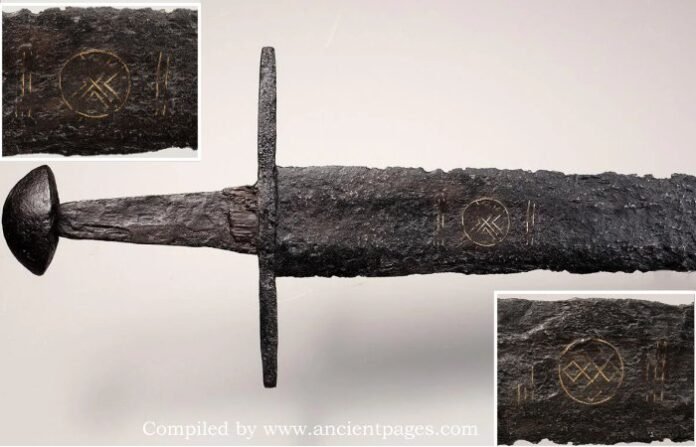Jan Bartek – AncientPages.com – Deep within a riverbed, a sword lay buried for nearly 1,000 years, remarkably preserved by the oxygen-poor soil. The sword was discovered during routine dredging in the Korte Linschoten River near Montfoort in Utrecht province in 2024. Workers noticed something unusual protruding from the sludge they retrieved—it was an intact three-foot sword.
This discovery has intrigued researchers due to the mysterious markings on its blade. Around 1,000 years ago, Christianity began spreading across northern Europe. During this period, Germanic chieftains and Viking kings gradually shifted from pagan beliefs to Christianity. However, archaeological finds suggest this transition was not always immediate or complete.
Now known as the Linschoten Sword, it dates back to between 1050 and 1150 CE when the Bishopric of Utrecht held regional influence and territories like Holland and Flanders were rising politically.
Credit: Landgoed Linschoten
The sword measures one meter in length and weighs 900 grams (1.85 pounds), featuring a broad crossguard of 17 centimeters and a Brazil nut-shaped pommel typical of Frankish smiths’ swords from that era. X-ray analysis has revealed traces of wood and leather on its handle—likely remnants of its original grip.
Suncross, the Christian symbol on the sword. Credit: Landgoed Linschoten
This rare medieval sword bears two significant symbols: one is a sun cross —a circle with a cross—which gained popularity with Christianity as solar crosses were often painted on churches during consecration ceremonies; the other is an engraving of an endless knot from Viking Age symbolism among Germanic tribes representing unbreakable bonds and protection, resembling Odin-associated Valknut designs.
The Viking symbol on the sword. Credit: Landgoed Linschoten
The Linschoten Sword is distinguished by three parallel lines of bronze inlay, which underscore the blade’s ritual and symbolic importance. The identity of the sword’s owner remains unknown, as does the reason for its presence in the river.
Experts from Leiden University have indicated that during that period, a sword served more as a status symbol than as a functional weapon. Valentijn explains that armies primarily engaged in combat using spears, which were more economical and simpler to produce. Consequently, possessing a sword was an indication of the owner’s wealth.
The sword in question is likely of Western European origin, with a strong possibility that it was crafted in what is now Germany. Additionally, there is a chance that the iron ore used to make the weapon came from the Veluwe region. Interestingly, no scabbard was found with it. These factors indicate that further research into the sword’s origins would be valuable and could provide more definitive insights.
Credit: Landgoed Linschoten
Researchers believe that the sword was likely placed deliberately into the river rather than being lost in battle. They are confident that this act served as a ritual offering, potentially to honor a deceased warrior or to sanctify land during a period when the area was still an undeveloped marshland undergoing colonization.
Conservator Hannelore Valentijn explained that the sword’s preservation was possible because it was retrieved from the river. She noted, “If you had just left it lying around after the discovery, it would quickly corrode and crumble. That’s why we had to take immediate action to preserve it.” The sword underwent a ten-week preservation process that involved desalination, rinsing, and drying, followed by a special coating to prevent further corrosion. This several-month-long project aimed at protecting, cleaning, and preserving the sword has now concluded with its donation to the Rijksmuseum van Oudheden in Leiden. Visitors can view this remarkable artifact as part of the museum’s exhibition.
See also: More Archaeology News
The Linschoten Sword is currently on display in the museum’s Acquisitions showcase, located in Temple Hall behind the Egyptian Temple, and will be available for viewing until August 2025.
Written by Jan Bartek – AncientPages.com Staff Writer











